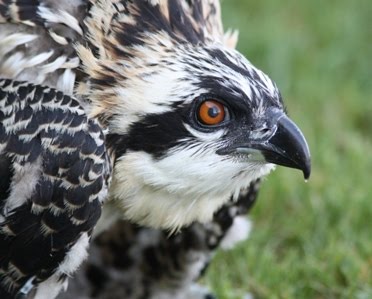Today I visited many nests, checking for successful fledging of the chicks. One nest I visited had previously held three chicks, but today I only saw two in the nest. Did we lose one here? Could one have fledged? Perhaps, but my search around the nest area revealed no other chick. I proceeded onto to the next nest, which was very close to the first nest. I found a single chick there, as there had been last time I visited. The male chick stood quietly, watching everything in his world, and then the adult male arrived carrying a fish, and right behind him was another screaming juvenile! I had never seen two chicks on this nest previously, and one was missing from the neighboring nest. Hmmmmmmmm. I have seen a chick move from one of these nests to another in the past, so I pondered that possibility. If the chicks had been banded I would know for sure, but since they weren't, I could only contemplate that possibility, as I chuckled.
One thing many of my volunteer monitors are noticing this time of year, as the young ones take flight, is that suddenly some of the females may be harder to find. They have remained steadfastly with their eggs, their chicks for so many months and now our visits often find no female present. It's usually only a temporary absence, but that is a change. This is the time of year that the bonds they have felt for their offspring begin to loosen a bit and the females begin the slow, subtle preparation for migration. The females can lose muscle mass after all the incubating, shading and feeding and now they are finally able to leave the nest and fly a bit, they begin catching a fish occasionally, bathing, perching near the nest instead of on it. Of course part of the reason for clearing out is all that flapping! As the chicks jump, flap, fly from one side of the nest to the other, there is little room for adults on a nest with three chicks. The females won't leave yet, but the behaviors do change, the males are stepping up their game, fishing, watching over the youngsters, they may follow him to the favorite fishing hole. I visited a nest where the homeowner shared that the chicks began fledging yesterday. So I snuck out to the backyard, using all my best raptor approaching skills...and I recieved no alarm calls. One chick still in the nest, the adult female in a nearby tree. I stayed down low, basically on my knees, scanning with my binoculars to try to find the other two chicks. Ah, there was one perched on a bench on a neighbors dock. And I finally spotted the other one perched on a boat cover near the other neighbors dock. Then the first chick began flying all around the shore of the lake and plunging into the water, and then mustering all his strength to get lift off out of the water...only to do it again, and again. It was so much fun to watch! He was practicing his water starts, already! It was not fishing, since there was no hovering, no looking into the water....just the in and out of the water activity. Developing a very necessary skill! It was delightful to witness. Pretty sure I heard the other chick, who was watching all this, say, "wow"!
